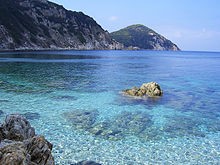Isola d’Elba - 1st June 2016
On the first four days of June Jan and I and a couple of friends had decided to take a short break to Elba. For many Lucchese this is an annual destination to explore what is termed the Tuscan archipelago, the small group of islands off the coastline in the Tyrrhenian Sea. Included in this group are the National Parks (Parco Nazionale) and smaller islands of Gorgona, Capraia, Pianosa, Montecristo, Isola del Giglio, Isola di Giannutri and the largest, most famous and our choice of Isola d’Elba.
The journey began with an easy drive to the port of Piombino that lies opposite Elba on the northern side of the Maremma which was once an unhealthy marshy area but was drained, repopulated and now with increased agritourism produces some of Italy’s finest wines such as Sassicaia (literally ‘stony field) an example of the ‘Super Tuscan’ production.
Piombino’s ancient historical centre was once the site of an ancient Etruscan port which in the Middle Ages was an important port of the Republic of Pisa. The hinterland is largely industrial and Piombino is a centre for both industry and tourism. In 1809 the area was, like Lucca, given by Napoleon to his sister Elisa Baciocchi.
The ferry from Piombino took us on the ten-kilometre trip to Elba which is part of the province of Livorno. We arrived at Rio Marina after forty-five minutes and drove across the island to our pleasant small hotel in Marciana Marina on the north-west coast.
View of Marciana Marina
Enfola beach, near Portoferraio
As one would expect of an island catering mostly for tourism there were plenty of beautiful areas to visit, good restaurants, excellent local wines and a friendly atmosphere. There is a long tradition of producing dessert wines in Elba from the red Italian grape variety Aleatico. Part of the ancient grape variety of Muscat wines, the Aleatico dell’Elba Passito DOCG is a dessert wine made from grapes that have been dried like raisins to concentrate the juice. It was a short evening stroll from our hotel to the marina area for some good pasta, coffee, gelati and of course the Aleatico wine. Although it was early June the weather was at times slightly overcast and just warm enough for a pleasant pre-dinner swim.
Each day we used our little Fiat 500 to explore all the major coastal towns which meant using many small narrow winding roads that had you longing for a non-existent stretch of straight of road. However, as with most of Italy, the pace remained unhurried and as the sun slowly began to shine we enjoyed interesting walks around the main towns of Portoferraio, Porto Azzurro and Capoliveri.
The island is of course famous as the place of exile for Napoleon and visits to his two places of abode, one in the town of Portoferraio and the other in the cooler countryside at San Martino where he had a small house extended to a private villa. Somewhat strangely visitors now see a small neo-classical palace there built by Demidoff in 1851 who was a great admirer of Napoleon.

